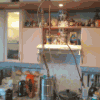оригинал
Process of whisky maturationThe effect of maturation on whisky is quite distinct, with the unmatured spirit generally having few of the desirable properties sought in whisky taste and aroma. Therefore the importance of the maturation process should not be underestimated. The following points are known about the maturation of whisky (Nishimura and Matsuyama, 1989):
1 Satisfactory maturation times may vary from 3 to more than 10 years.
2 There is normally a significant flavour difference between matured and unmatured spirits.
3 Volume and strength are lost due to the evaporation of water and alcohol through the porous wood of the casks.
4 Maturation time and the quality of the matured spirit may vary according to the type of whisky, the size, wood type and prior treatment of the cask and the environment in which the whisky is matured.
The mechanisms by which maturation in oak casks occurs are incompletely understood. Research has been carried out to identify compounds that contribute to the flavour or aroma of whisky, referred to as flavour congeners.
Correlations between descriptive flavours and chemical analyses of mature whiskies, have identified over 400 flavour congeners (Philp, 1989a). The principle ones are esters, carbonyls, sulphur compounds, lactones, phenols, and nitrogenous bases, including both desirable and undesirable components. In some cases the origin and method of synthesis have been further studied and the involvement of the maturation stage confirmed. Changes in taste or aroma will be due to changes in these flavour congeners.
The methods by which this may occur, during the maturation of whisky in oak casks, are listed below (Nishimura and Matsuyama 1989):
1 Direct extraction of wood chemicals.
2 Decomposition of wood macromolecules and extraction of these into the distillate.
3 Reactions between wood components and constituents of the raw distillate.
4 Reactions involving only the wood extractives.
5 Reactions involving only the distillate components.
6 Evaporation of volatile compounds through the cask.
However, as emphasized by Piggott et al. (1992) it is the concentration in the 'headspace' (the air space in the cask or container) rather than in the mature spirit that determines the influence on flavour of many volatiles. The concentration of volatiles in the headspace will be influenced by any factors affecting their solubility in the distilate, including the concentrations of involatile compounds.
Canaway (1983) described how the variation of samples from different casks could equal the variation between samples of differing age. Such variation between casks could be due to differences in the raw distillate, the conditions of maturation or the cask wood.
Although both the raw distillate and particularly the conditions of maturation may play an important role in determining the result of maturation, the oak cask in which maturation takes place appears to be of prime importance to the final flavour of whisky (Williams, 1983a). The type of cask can affect both the taste, colour and aroma of whisky. The desired effect of maturation will depend upon the nature of the immature whisky. It may sometimes be desired that the oak wood contribute significantly to the flavour, while for other whiskies, perhaps with an already characteristic taste, the desired effect of maturation may be less. The time taken to reach a satisfactory condition is of financial and practical concern for the manufacturer and varies according to the type of cask used.
перевод
Процесс созревания вискиВлияние созревания на виски весьма отчетливо, поскольку недозрелый спирт, как правило, обладает лишь немногими из желательных свойств, которые можно найти во вкусе и аромате виски. Поэтому важность процесса созревания не следует недооценивать. Следующие пункты известны о созревании виски (Нисимура и Мацуяма, 1989):
1 Время созревания может варьироваться от 3 до более 10 лет.
2 Как правило, между зрелыми и незрелыми спиртами существует значительная разница вкуса.
3 Объем и крепость теряются из-за испарения воды и спирта через пористую древесину бочек.
4 Время созревания и качество выдержанного спирта могут варьироваться в зависимости от типа виски, размера, типа древесины и предшествующей обработки бочки и условий, в которых выдерживается виски.
Механизмы, по которым происходит созревание в дубовых бочках, до конца не изучены. Были проведены исследования для выявления соединений, которые способствуют вкусу или аромату виски, которые называются конгенерами вкуса.
Корреляции между ароматическими веществами и химическим анализом зрелых сортов виски позволили выявить более 400 вкусовых конгенеров (Philp, 1989a). Основными из них являются сложные эфиры, карбонильные соединения, соединения серы, лактоны, фенолы и азотистые основания, включая как желательные, так и нежелательные компоненты. В некоторых случаях происхождение и метод синтеза были дополнительно изучены и подтверждено участие стадии созревания. Изменения вкуса или аромата будут вызваны изменениями в этих конгенерах вкуса.
Методы, с помощью которых это может происходить во время выдержки виски в дубовых бочках, перечислены ниже (Nishimura and Matsuyama 1989):
1 Прямое извлечение веществ древесины.
2 Разложение макромолекул древесины и извлечение их в дистиллят.
3 Реакции между древесными компонентами и компонентами сырого дистиллята.
4 Реакции с участием только древесных экстрактивных веществ.
5 Реакции с участием только компонентов дистиллята.
6 Испарение летучих соединений через бочку.
Однако, как подчеркивали Пигготт и соавт. (1992), именно концентрация в «свободном пространстве» (воздушном пространстве в бочке или контейнере), а не в созревшем спирте, определяет влияние на аромат многих летучих веществ. На концентрацию летучих веществ в свободном пространстве будут влиять любые факторы, влияющие на их растворимость в дистилляте, в том числе концентрации нелетучих соединений.
Canaway (1983) описал, как вариация образцов из разных бочек может равняться вариации между образцами разного возраста. Такое различие между бочками может быть связано с различиями в сыром дистилляте, условиях созревания или древесине бочки.
Хотя и сырой дистиллят, и особенно условия созревания, могут играть важную роль в определении результата созревания, дубовая бочка, в которой происходит созревание, кажется, имеет первостепенное значение для окончательного вкуса виски (Williams, 1983a). Тип бочки может влиять как на вкус, цвет и аромат виски. Желаемый эффект созревания будет зависеть от характера незрелого виски. Иногда может быть желательно, чтобы древесина дуба вносила значительный вклад в аромат, в то время как для других сортов виски, возможно, с уже характерным вкусом, желаемый эффект созревания может быть меньше. Время, необходимое для достижения удовлетворительного состояния, представляет финансовую и практическую озабоченность для производителя и варьируется в зависимости от типа используемой бочки.











